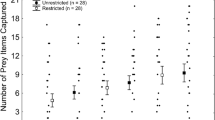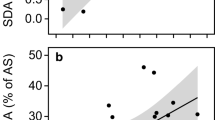Abstract
Most animals will reduce foraging activity in the presence of a predatory threat. However, little is known about the onset of this decision-making ability during the early life stages of fishes, and how the trade-off between foraging and predator-avoidance may be affected by changes in metabolic demand during ontogeny. To examine these issues, the foraging behaviour of larval shorthorn sculpin Myoxocephalus scorpius was monitored during visual exposure to a predatory threat (juvenile Atlantic cod, Gadus morhua) throughout development at 3°C (March–April, 2004). Larvae did not respond to predatory exposure during the first week post-hatch, but thereafter showed drastic reductions in foraging activity when exposed to predators. During early development, the mass-specific routine metabolism of shorthorn sculpin larvae displayed a triphasic ontogeny and peaked during metamorphosis. This high mass-specific metabolic demand could make reduced foraging under predation threat very costly during this stage of development. To further investigate this possibility, additional experiments were performed (March–April, 2005) where larvae were reared with visual exposure to predators for 6 h day−1 during the feeding period. At 7-week post-hatch, larvae exposed to predators were smaller (wet mass and SL), showed decreased levels of whole-body lipids and certain fatty acids, and experienced higher rates of mortality as compared to control larvae. In environments where abundant predators cause larval fish to reduce their foraging rate, growth and survival of larvae may be negatively affected.






Similar content being viewed by others
References
Adams SM (1999) Ecological role of lipids in the health and success of fish populations. In: Arts MT, Wainman BC (eds) Lipids in freshwater ecosystems. Springer, New York
Alkanani T, Parrish CC, Rodnick KJ, Gamperl AK (2005) Lipid class and nonesterified fatty acid profiles in plasma of North Atlantic cod (Gadus morhua). Can J Fish Aquat Sci 52:2509–2518
Almatar SM (1984) Effects of acute changes in temperature and salinity on the oxygen uptake of larvae of herring (Clupea harengus) and plaice (Pleuronectes platessa). Mar Biol 80:117–124
Altmann J (1974) Observational study of behaviour: sampling methods. Behaviour 49:227–265
Bailey KM, Batty RS (1984) Laboratory study of predation by Aurelia aurita on larvae of cod, flounder, plaice, and herring: development and vulnerability to capture. Mar Biol 83:287–291
Bailey KM, Houde ED (1989) Predation on eggs and larvae of marine fishes and the recruitment problem. Adv Mar Biol 25:1–89
Ball SL, Baker RL (1996) Predator-induced life history changes: antipredator behavior costs facultative life history shifts? Ecology 77:1116–1124
Barlow GW (1968) Ethological units of behaviour. In: Ingle DJ (ed) The central nervous system and fish behaviour. University of Chicago Press, Chicago
Bell MV, Batty RS, Dick JR, Fretwell K, Navarro JC, Sargent JR (1995) Dietary deficiency of docosahexaenoic acid impairs vision at low light intensities in juvenile herring (Clupea harengus L.). Lipids 30:442–449
Bell JG, McEvoy LA, Estevez A, Shields RJ, Sarent JR (2003) Optimising lipid nutrition in first-feeding flatfish larvae. Aquaculture 227:211–220
Bishop TD, Brown JA (1992) Threat-sensitive foraging by larval threespine sticklebacks (Gasterosteus aculeatus). Behav Ecol Sociobiol 31:133–138
Biro PA, Abrahams MV, Post JR, Parkinson E (2004) Predators select against high growth rates and risk-taking behaviour in domestic trout populations. Proc R Soc Ser B 271:2233–2237
Copeman LA, Parrish CC, Brown JA, Harel M (2002) Effects of docosahexaenoic, eicosapentaenoic, and arachadonic acids on the early growth, survival, lipid composistion and pigmentation of yellowtail flounder (Limanda ferrunginea) a live food enrichment experiment. Aquaculture 210:285–304
Eaton RC, DiDomenico R (1986) Role of the teleost escape response during development. Trans Amer Fish Soc 115:128–142
Evans BI, Browman HI (2004) Variation in the development of the fish retina. Am Fish Soc Symp 40:145–166
Finn RN, Ronnestad I, van der Meeren T, Fyhn HJ (2002) Fuel and metabolic scaling during the early life stages of Atlantic cod Gadus morhua. Mar Ecol Prog Ser 243:217–234
Folch J, Lees M, Sloane-Stanley GH (1957) A simple method for the isolation and purification of total lipids from animal tissues. J Biol Chem 22:497–509
Folkvord A, Hunter JR (1986) Size-specific vulnerability of northern anchovy, Engraulis mordax, larvae to predation by fishes. Fish Bull US 84:859–869
Fraser DF, Huntingford FA (1986) Feeding and avoiding predation hazard: the behavioral response of the prey. Ethology 73:5–68
Fuiman LA (1994) The interplay of ontogeny and scaling in the interactions of fish larvae and their predators. J Fish Biol 45(Suppl A):55–79
Fuiman LA, Magurran AE (1994) Development of predator defences in fishes. Rev Fish Biol 4:145–183
Giguere LA, Cote B, St.-Pierre J-F (1988) Metabolic rates scale isometrically in larval fishes. Mar Ecol Prog Ser 50:13–19
Godin J-GJ, Crossman SL (1994) Hunger-dependent predator inspection and foraging behaviors in the threespine stickleback (Gasterosteus aculeatus) under predation risk. Behav Ecol Sociobiol 34:359–366
Godin J-GJ, Smith SA (1988) A fitness cost of foraging in the guppy. Nature 333:69–71
Gotceitas V, Godin J-GJ (1991) Foraging under the risk of predation in juvenile Atlantic salmon (Salmo salar L.): effects of social status and hunger. Behav Ecol Sociobiol 29:255–261
Glazier DS (2005) Beyond the ‘3/4-power law’: variation in the intra- and interspecific scaling of metabolic rate in animals. Biol Rev 80:611–662
Helfman GS (1989) Threat-sensitive predator avoidance in damselfish-trumpetfish interactions. Behav Ecol Sociobiol 24:47–58
Houde ED, Schekter RC (1983) Oxygen uptake and comparative energetics among eggs and larvae of three subtropical marine fishes. Mar Biol 72:283–293
Kamler E (1992) Ontogeny of yolk-feeding fish: an ecological perspective. Rev Fish Biol 12:79–103
Killen SS, Brown JA (2006) Energetic cost of reduced foraging under predation threat in newly hatched ocean pout. Mar Ecol Prog Ser 321: 55–266
Killen SS, Costa I, Brown JA, Gamperl AK (2007) Little left in the tank: metabolic scaling in marine teleosts and its implications for aerobic scope. Proc R Soc Ser B 274:431–438
Kjorsvik E, Pittman K, Pavlov D (2004) From fertilization to the end of metamorphosis—functional development. In: Moksness E, Kjorsvik E, Olsen Y (eds) Culture of cold-water marine fish. Blackwell Publishing, Oxford
Lima SL (1998) Nonlethal effects in the ecology of predator-prey interactions. Bioscience 48:25–34
Lima SL, Dill LM (1990) Behavioral decisions made under the risk of predation: a review and prospectus. Can J Zool 68:619–640
McKenzie DJ, Higgs DA, Dosanjh BS, Deacon G, Randall DJ (1998) Dietary fatty acid composition influences swimming performance in Atlantic salmon (Salmo salar) in seawater. Fish Physiol Biochem 19:111–122
Methven DM, Brown JA (1991) Time of hatching affects development, size, yolk volume, and mortality of newly hatched Macrozoarces americanus (Pisces: Zoarcidae). Can J Zool 69:2161–2167
Noakes DLG, Godin J-GJ (1988) Ontogeny of behavior and concurrent developmental changes in sensory systems in teleost fish. In: Hoar WS, Randall DJ (eds) The physiology of developing fish, part B: viviparity and posthatching juveniles, vol 11 of Fish Physiology. Academic, San Diego
Oikawa S, Itazawa Y, Gotoh M (1991) Ontogenetic change in the relationship between metabolic rate and body mass in a sea bream Pagrus major (Temminck & Schlegel). J Fish Biol 38:483–496
Parrish CC (1998) Determination of total lipid, lipid classes, and fatty acids in aquatic samples. In: Arts MT, Wainman BC (eds) Lipids in freshwater ecosystems. Springer, New York, pp 4–12
Peck MA, Buckley LJ, Bengston DA (2003) Energy losses due to routine and feeding metabolism in young-of-the-year juvenile Atlantic cod (Gadus morhua). Can J Fish Aquat Sci 60:928–937
Pettersson LB, Bronmark C (1993) Trading off safety against food: state dependent habitat choice and foraging in crucian carp. Oecologia 95:353–357
Post JR, Lee JA (1996) Metabolic ontogeny of teleost fishes. Can J Fish Aquat Sci 53:910–923
Sargent J, McEvoy L, Estevez A, Bell G, Bell M, Henderson J, Tocher D (1999) Lipid nutrition of marine fish during early development: current status and future directions. Aquaculture 179:217–229
Scott WB, Scott MG (1988) Atlantic fishes of Canada. Can Bull Fish Aquat Sci 219:507–509
Skajaa K, Ferno A, Folkvord A (2003) Swimming, feeding and predator avoidance in cod larvae (Gadus morhus L.): trade-offs between hunger and predation risk. In: Browman HI, Skiftesvik AB (eds) The big fish bang. Proceedings of the 26th annual larval fish conference. Institute of Marine Research, Bergen, Norway
Skelly DK (1992) Field evidence for a cost of behavioral antipredator response in a larval amphibian. Ecology 73:704–708
Sokal RR, Rohlf FJ (1995) Biometry, 3rd edn. W.H. Freeman and Company, New York, USA
Stearns SC (1992) The evolution of life histories. Oxford University Press, New York
Stoks R, De Block M, van de Meutter F, Johansson F (2005) Predation cost of rapid growth: behavioural coupling and physiological decoupling. J Anim Ecol 74:708–715
Temple S, Cerqueira VR, Brown JA (2004) The effects of lowering prey density on the growth, survival and foraging behaviour of larval fat snook (Centropomus parallelus poey 1860). Aquaculture 233:205–217
Tocher DR (2003) Metabolism and function of lipids and fatty acids in teleost fish. Rev Fish Sci 11:107–184
Weiser W (1991) Limitations of energy acquisition and energy use in small poikilotherms: evolutionary implications. Funct Ecol 5:234–240
Weiser W (1995) Energetics of fish larvae, the smallest vertebrates. Acta Phyiol Scan 154:279–290
West GB, Brown JH, Enquist BJ (1997) A general model for the origin of allometric scaling laws in biology. Science 276:122–126
Williams PJ, Brown JA (1991) Developmental changes in foraging-predator avoidance trade-offs in larval lumpfish Cyclopterus lumpus. Mar Ecol Prog Ser 76:53–60
Wuenschel MJ, Werner RG, Hoss DE (2004) Effect of body size, temperature, and salinity on the routine metabolism of larval and juvenile spotted seatrout. J Fish Biol 64:1088–1102
Acknowledgements
This work was supported by Memorial University of Newfoundland, Natural Sciences and Engineering Research Council of Canada (NSERC) Discovery Grants to JAB and AKG, a Canada Foundation for Innovation-New Opportunities Grant to AKG, and an NSERC post-graduate scholarship to SSK. We thank the technical services division of the OSC, the staff of the Dr. Joe Brown Aquatic Research Building (JBARB) for the rearing of Artemia sp. used in this study, and Phillip Sargent, Rene Boland, and Bob O’Donnell for the collection of the sculpin eggs. We also thank Dr. David Schneider for his assistance with statistical analyses, and Dr. Mark Abrahams and three anonymous reviewers for providing comments on an earlier version of this manuscript. Finally, we are grateful to Dr. Chris Parrish for allowing us to use his laboratory to perform the lipid analyses, and to Vanessa French and Jeanette Wells for their technical assistance. This study was conducted in accordance with the laws of Canada and guidelines of the Canadian Council on Animal Care and the Animal Care Committee of Memorial University of Newfoundland.
Author information
Authors and Affiliations
Corresponding author
Additional information
Communicated by J.P. Grassle.
Electronic supplementary material
Rights and permissions
About this article
Cite this article
Killen, S.S., Gamperl, A.K. & Brown, J.A. Ontogeny of predator-sensitive foraging and routine metabolism in larval shorthorn sculpin, Myoxocephalus scorpius . Mar Biol 152, 1249–1261 (2007). https://doi.org/10.1007/s00227-007-0772-3
Received:
Accepted:
Published:
Issue Date:
DOI: https://doi.org/10.1007/s00227-007-0772-3




